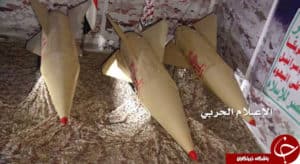Since July, state-affiliated media in Iran has publicized the Yemeni Houthi movement’s use of a model of the Zelzal-3, an Iranian rocket. Iranian media and the Houthis (officially known as Ansar Allah), however, insist that this model has been produced “indigenously” in Yemen. While prominent government officials in Tehran regularly tout their political support for Ansar Allah, they often reject the charge of military assistance to their campaign. Moreover, despite ambiguity over the degree to which Tehran can control Ansar Allah, the Islamic Republic’s military aid to the group is readily apparent, and has been noted by senior American officials. As such, Ansar Allah’s display and deployment of rockets that feature the same name and number as Iranian rockets further serves to strengthen those ties.
The Zelzal, meaning “earthquake” in Persian and Arabic, is a type of unguided, mobile Iranian artillery rocket. The Islamic Revolutionary Guard Corps (IRGC) produced the Zelzal platform during Iran-Iraq War (1980-1988), and is reportedly one of the first rockets ever fired by Tehran during the conflict. Although some analysts classify it and the larger Zelzal family as a short-range ballistic missile, Iranian sources attest that it is a surface-to-surface, solid-fueled, “short-range rocket.” The Zelzal comes in three different forms, and can travel upwards of 300 km with a warhead that can “shower” its target with sub-munition payloads. Iran publicly debuted the Zelzal-3 at a military parade in 2007.
Ansar Allah’s Zelzal-3 may be a variant of the original Iranian version. A closer look at the Zelzal-3 that the Houthis claim to have domestically produced does not appear to exactly match the Iranian Zelzals. The former have larger fins and shorter bodies, while the Iranian model is longer and can be fired from rail launchers. Iranian media nonetheless has not been shy about highlighting the successful launching of several Zelzals towards southern Saudi Arabia just this past week.
The Zelzal may not be the first rocket or missile platform that links Tehran to Ansar Allah. In December 2015, the Houthis revealed the Qaher-1 ballistic missile. According to Janes, this was based off of the Soviet S-75 (SA-2), a surface-to-air missile long present in Yemen. While the IRGC-affiliated Tasnim News Agency ran a lengthy article praising Ansar Allah for developing this missile, it also denied Iranian military support to the endeavor, claiming that the blockade surrounding Yemen rendered transfers of such technology impossible. As early as 2014, however, Iran had developed a model of the SA-2, and called it the “Sayyad.”
Iran has a history of reverse-engineering projectiles, as well as providing some of these model to its allies. Yet, considering the above-mentioned blockade, the method for transferring the weapon remains unclear. The most likely scenario would involve the IRGC, which may have provided know-how through either the Qods Force or Hezbollah, though the former leads all extraterritorial operations for the IRGC, which in turn produces missiles and oversees Iran’s missile command. In May 2015, U.S. intelligence officials affirmed that both the Qods Force and Hezbollah are active in Yemen. The Qods Force deputy commander Esmail Gha’ani himself has proclaimed that Houthi rebels have been trained “under the flag of the Islamic Republic.” Hezbollah reportedly operates a “train-and-equip program” there.
There is a precedent for the IRGC’s proliferation of the Zelzal platform to militias. Iran previously transferred the technology and know-how to deploy the Zelzal-2, a 610 mm variant of the original Zelzal, to IRGC proxies, such as Lebanese Hezbollah and Palestinian Islamic Jihad. The Guard has also equipped Hezbollah with other model of IRGC-produced rockets and missiles. In July, the deputy commander of the IRGC, Hossein Salami, exclaimed that Hezbollah possessed a stockpile of more than “100,000 missiles.” The history of Iranian missile transfer to allies, along with the Iranian media’s brandishing of the successful firing of the Zelzal-3, suggests that the IRGC or its proxies are implicated in the provision of either material or know-how for the latest rocket used by Ansar Allah in the Arabian Peninsula.

Zelzal-3 model used by Ansar Allah.

Zelzal-3 triple launcher during a 2012 military parade in Tehran.

Zelzal-3 fired during IRGC’s Great Prophet VI military exercise.







